| NAVAL ORDNANCE AND GUNNERY VOLUME 2, FIRE CONTROL CHAPTER 21 BATTERY ALIGNMENT |
| HOME INDEX Chapter 21 Battery alignment A. Alignment of gun sights B. Train alignment in drydock C. Elevation alignment in drydock D. Battery alignment afloat E. Firing stop mechanisms |
| 21B2. Preliminary work 1. Transmission check. Before proceeding to check the synchro transmission system to assure (1) that various transmitters are sending out a correct electrical signal for a given mechanical input, and (2) that receivers are converting this electrical signal into a mechanical motion equal to that of the transmitters. It is first necessary to set the synchros to electrical zero. Any of several methods may be used, and each synchro dial should read zero when that synchro is on electrical zero. The next step is to check transmission, which is accomplished as follows: a. Man the telephones at the stations to be tested. b. Set the switchboard in turn to transmit from: (1) The directors to plot. (2) Plot to the guns. (3) The directors to the guns directly (where possible, by-passing the rangekeeper or computer). (4) The stable element to the directors (to transmit level and crosslevel). c. Turn the transmitter to various readings, usually in 10° increments throughout its operating range, and compare the receiver readings with the transmitted values. They should check exactly. Any errors of position, direction, or firmness of position should be investigated by standard synchro methods. Particular attention should be paid to the action of the receiver dials when coming to rest. They should stop quickly and evenly in agreement, and there should be neither sluggishness nor long oscillation. 2. Establishing an offset centerline. The centerline itself cannot be used for alignment because of ship’s structures in the way. Therefore, the first step is to establish an offset centerline. This is normally a line on shore which is parallel to the centerline of the ship. The offset centerline is usually determined and definitely marked by the yard force. However, it is well for the gunnery officer or a representative of his department to check with the yard throughout the whole procedure. The transit, which is an instrument employed in surveying, is used in establishing the offset centerline and for other steps in battery alignment. The instrument makes possible accurate measurement of horizontal and vertical angles. Though transits vary in details of construction, the basic principles are always the same. A plate with a graduated circle, or azimuth scale, is carried on a tripod support. This plate can be positioned in a true horizontal plane by means of levels and adjusting screws fitted to it. A separate plate, which can be rotated in the horizontal plane, concentric with the azimuth plate, supports a telescope. The telescope is mounted in bearings which allow movements in a vertical plane also, and therefore permit measurement of vertical angles. To measure horizontal angles, the telescope plate is moved until its zero mark is lined up with the zero mark of the azimuth plate. It is then clamped to the azimuth plate in this position. The two plates are then rotated together until the telescope crosshairs line up with a distant point on the reference line being established. A plumb bob on the instrument locates the transit on the reference line at the vertex of the angle being measured. If the azimuth plate is now being clamped to the support and the telescope plate is unclamped, angles can be measured from the established reference line at the chosen vertex point. Both the scale for reading these angles and the one for reading the vertical angles are usually equipped with vernier adjustments which permit readings to fractions of a minute of arc. |
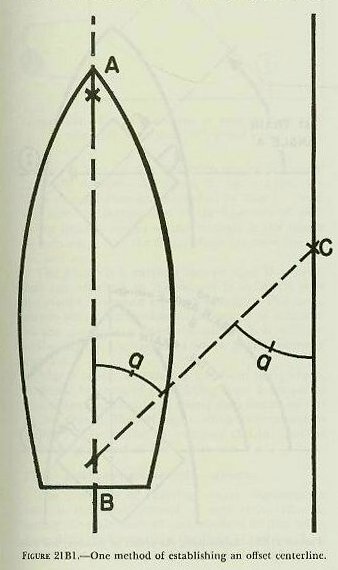 |
| If there can be found on the actual centerline of the ship two points which are visible from each other, the procedure which follows is quite simple (refer to fig. 2lBl). 1. Set up a transit over B, one of the points on the centerline. Lock the telescope plate at the zero point on the azimuth scale and sight on the other point, A, on the centerline. Clamp the azimuth plate to the transit support. 2. Select some other point on shore through which the offset centerline is to be established, such as C. (Either side may be used.) Unclamp the telescope plate from the azimuth plate and sight on point C. Read and record the corresponding angle, a. 3. Then set up transit at C. With the telescope set on zero azimuth and locked, sight back on B. Lock the azimuth plate at this position. Then release the telescope plate, set it at an angle a, and lock. The transit telescope is now pointed parallel to the centerline of the ship. 4. Establish other points in the offset centerline by setting up stakes in the line of sight of the transit. If no two points can be found on the ship’s centerline which are visible from each other, the following method must be employed: I. Select two points; one on either side of the ship (C and D), which can be seen from each other and also from two points on the centerline (A and B). (See fig. 21B2.) 2. Set up the transit over A, B, C, and D in turn, and measure angles a, b, c, d, e, and f. 3. The value of angle x may then be computed, using the data obtained in step 2. The following formula may be used in making this comparison: |
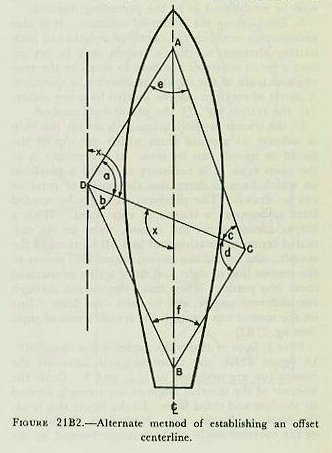 |
| Work sheets are available which simplify the computation of angle x by logarithms. 4. Set up the transit over D and sight on C. Rotate the telescope plate through the angle x, and the telescope is then parallel to the centerline of the ship. Other points on the offset centerline may now be established as in the preceding method. 3. Establishing the center of rotation. It is also necessary to establish the center of rotation of each battery element, so that a transit may be set up over a given center of rotation to measure the true angle of train of the mount or director in question. A center of rotation may be located by using either: (1) the transit, or (2) the plumb-bob method. In the transit method, a transit is set up (on ship or ashore) at a point from which the top of the shield or mount can be seen. If the mount is of the open type, it is necessary to build a platform on which lines to determine the center of rotation can be drawn. The platform will also be needed later to support a transit at this point. With a helper stationed on the mount, sight on its estimated center of rotation and lock all motions of the transit. On top of the mount locate two points in the transit line of sight and draw a line connecting these two points. Then train the mount through two different angles, and in each case draw a line on the mount top through the transit’s line of sight (see fig. 21B3). Case 1: Sum of two train angles is less than 180°. In figure 21B4, the three original lines on the mount top are designed as 1, 2, and 3. Draw the bisector of the interior angle of the triangle formed by the first and third lines. In the figure this is ob, the bisector of angle cba. Next draw the bisector of the exterior angle of the triangle formed by the first and second lines. In the figure this bisector is ao, and the angle is cae. Finally, draw the bisector of the exterior angle formed by the second and third lines. In the figure this bisector is co and the angle is acf. The intersection of these bisectors is the center of rotation, o. Case 2: Sum of the two train angles is greater than 180 degrees. As shown in figure 2lB5, the three original lines are labeled as in Case 1. Note also that the intersection of the bisectors of each of the interior angles of the triangle is the center of rotation, o. In the figure these bisectors are oa, ob, and oc. The plumb-bob method can be used if a structure not attached to the mount is available over the mount. Suspend a plumb bob from this structure so that it hangs close to the center of rotation. As the mount is trained the plumb bob will describe a circle, the center of which is the center of rotation. After a center of rotation has been determined, it should be checked by sighting from a transit to assure that this calculated center does not move out of the transit line of sight when the mount is trained. The center of rotation should then be permanently marked for future use. 21B3. Establishing zero train-director The first step in effecting actual alignment in train is the establishment of zero train; that is, setting the train dials of each element so that when these dials read zero train the light of sight or bore axis of the element in question is parallel to the centerline of the ship and pointing forward. Zero train of a director is established as follows: 1. Select some point on shore (M in fig. 21B6) from which the director and some point (C) on the offset centerline can both be seen. This point (M) is the reference point, and will be used for zeroing all elements that can be seen from it. 2. Set up a transit over C, lock telescope at zero on azimuth scale, and sight forward along the offset centerline at some point (N). Lock the azimuth plate movement, release the telescope plate, and sight on M. Read and record the angle (a). 3. Set up a transit over M, lock the telescope at zero on azimuth scale, and sight back at C. Lock the azimuth plate, release the telescope plate, and sight on the center of rotation of the director (previously established and marked). Read and record this angle (b). 4. Train the director until the reference telescope (usually the pointer’s), which in this discussion is considered as being located on the centerline of the director and properly aligned with all other parts of the director assembly, is sighted directly on I\f. Make sure that parallax is not present in the telescope, and also that no horizontal parallax is being introduced into the director dials by its parallax mechanism. 5. Set up a transit over the director’s center of rotation, lock telescope at zero on azimuth scale, sight back at point M, and lock azimuth plate. Now both the transit and the reference telescope are sighted on M. 6. Study of figure 21B6 shows that the director and the transit are trained from the true fore-and. aft direction by the angle e. This angle (e) is equal to angle a plus angle b. 7. Release the telescope plate of the transit, and turn it aft until it reads the angle e (or a + b). Lock the telescope plate. 8. Now train the director forward until the transit is again on point M. Obviously, the director has been trained forward through angle e, and now is exactly parallel with the centerline of the ship. Adjust the dials until they read zero train at this point, and adjust the transmitters so that they transmit zero train. For purposes of checking director zero train at sea, a bench mark and a bench-mark reading are established. The bench mark usually is a small brass plate with crosslines etched on it. This plate is welded to a secure part of the ship within vision of the director sights. After zero director train has been established and the dials set, train the director and put the crosswires of the pointer’s telescope on the bench mark, and read the train angle-reader dials. This is the benchmark reading which should be recorded. The same telescope must be used for obtaining all settings and readings. On multiple director installations the parallax corrector must be set for infinity-the point at which no parallax correction is entered into the train dials. 21B4. Establishing zero train-turrets To establish zero train of a gun mount or turret, the guns (not the sights) are sighted on reference point M (see fig. 21B6). To do this, a boresight telescope is put in the barrel of a single mount, or in the middle barrel of a triple mount and sighted on i\l. The boresight telescope must have its line of sight at the centerline of the bore. Then a transit is set up over the center of rotation, and sighted on M to establish zero. The transit is offset the sum of a and b away from the bow, and is secured. The mount is then trained until the transit is again sighted on M. This is zero train, and the dials may be set at 0 degrees (180° in the case of the after guns). When a two-gun turret is at zero train, both gun bores should be parallel (within practical limits) to the centerline of the ship. Therefore, a somewhat different procedure is necessary to establish zero train, because both guns are offset from the center of the turret. The steps are as follows. Set up a transit over the turret’s center of rotation and install a boresight telescope in each gun. Train the turret until gun A is sighted on reference M. Establish zero for the transit by training it on reference M. See figure 21B7 (A). Now train the turret until gun B is on M, sight the transit on M and read the angle d turned off by the transit. See figure 21B7 (B). Then d/2 is the angle at M formed by the lines of sight of the transit and gun B. Starting with the transit and gun B trained on M, turn the transit to the left through the angle equal to e-d/2 (see figure 21B8). The forward gun A could be used, but the angle in this case would be e + d/2. Then train the turret until the transit is again sighted on M, and the turret will be at zero train. The dials should then read zero. Be sure that there is no parallax input to the turret and dials. In the case of the after turret (fig. 21B8) the angle turned toward the bow by the transit is g-d/2; then the turret is trained aft until the transit is on M again. Dials should read 180 degrees. 21B5. Trams and tram marks A reference point for each turret or mount must be established in order to check gun train at sea. Since very few guns can depress enough to point at a bench mark on the deck, a different type of reference is used. Such a reference is established when two marks or blocks, one on the fixed portion of the mount and one on the movable portion, are a definite distance apart when the mount is at a known angle. At any future time the mount can be trained until these two marks are separated by the specified distance, whereupon the mount will be at the previously established angle and the train dial reading may be checked. The distance between the two marks is established by a tram, and the marks or blocks are known as tram marks or tram blocks. Trams are of two types: the older nontelescopic, and the newer telescopic. The nontelescopic tram consists of a single piece of steel with an offset machined point at each end. These points are aligned with the tram marks to establish the predetermined angle. The telescopic tram (see fig. 21B9) consists of an outer tube within which slides a separate bar. Motion of the bar into the tube is resisted by a coil spring carried in the latter part. As shown in the figure a small window with an index mark is cut in the tube. Another index mark on the bar can be viewed through the window. When the marks on tube and bar line up, the tram is properly set for checking dial readings. This is done by inserting the tram between two tram blocks and training the mount until the index marks line up. The turret train dials should then read the value of actual turret train, which was determined at the last check of zero train in drydock. The tram can be checked by inserting it in the gage. If the scribe marks line up, it is correct. A number of methods are used to effect initial establishment of the tram blocks, only one of which will be described here. The mount is set at a known angle of train (0° or 180° if possible), using transit methods. Then the tram blocks are welded in place-one on the moving portion of the mount and one on the fixed portion-the approximate length of the tram apart. The tram is then inserted, and the sliding or threaded tram-block rods, which pass through the tram blocks as shown, are adjusted until the scribe marks on the tram are aligned, whereupon such adjustable members are spot-welded or peened. The angle of the mount’s train is then inscribed on the tram-block plate and entered in the battery logs for future checking. 21B6. Dial accuracy check A dial accuracy check in train is made to ensure that the dials accurately indicate the angular movement of the mount. It is done by comparing the angular position of the mount at previously chosen intervals, as indicated by its dial, with these positions as measured by accurate survey methods. During this test the parallax input should be zero. The procedure is as follows: I. Select a fairly distant point with a good vertical edge for a target. 2. Set up a transit over the center of rotation. 3. Train the director of mount to zero train. 4. Lock telescope at zero on the azimuth scale; sight the transit on the target and lock. 5. Train the mount 10° by the angle-reader dial. Always come up to, but never pass, the desired mark on the dial. 6. Turn the transit back on the target; read and record the actual angle turned, which should be 10 degrees. 7. Train the mount to 20° by the angle-reader dial. 8. Turn the transit back on the target and read from the transit the angle trained, which also should be 10° (total transit reading 20°). 9. Continue the foregoing procedure for 360° (or to the limit of train) and then repeat in the opposite direction for 360° (or to the limit of train) to check for lost motion. |
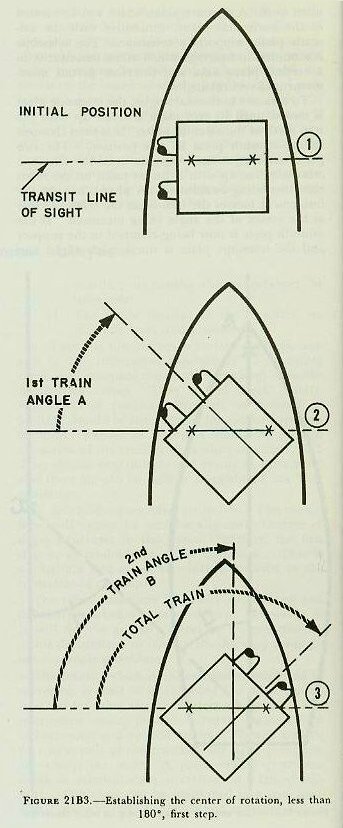 |
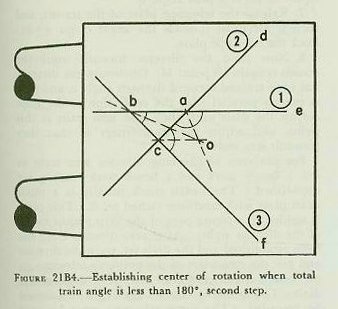 |
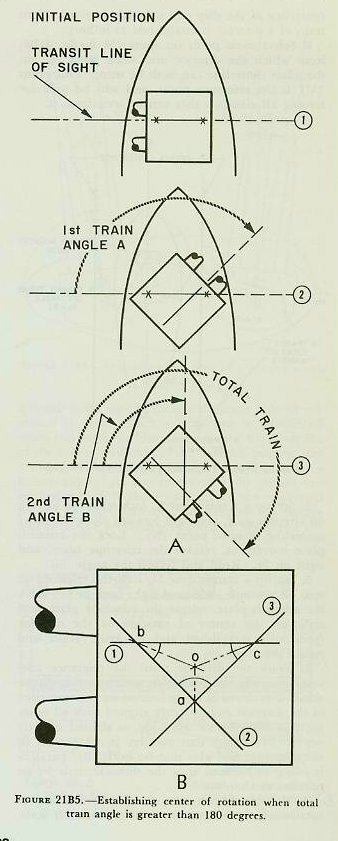 |
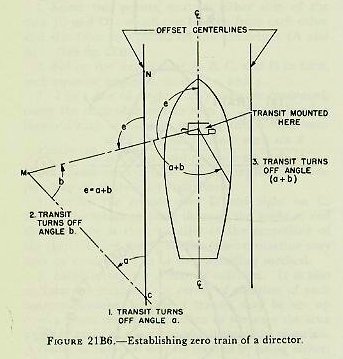 |
| B. Train Alignment in Drydock 21B1. Train alignment in drydock The purpose of the train alignment is to adjust the battery so that the lines of sight of directors and guns and axes of gun bores are parallel at all angles of train when no ballistics or horizontal parallax are considered and the dials are matched. This is accomplished initially by aligning each element to the centerline of the ship, which is the line of 0° train. Space limitations will not permit full discussion of all alignment procedures applicable to specific installations, for these installations are many and varied. The following discussion is limited to general procedures and principles used for batteries of 5-inch guns or larger, without reference to particular systems. |
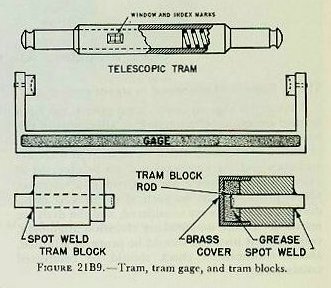 |
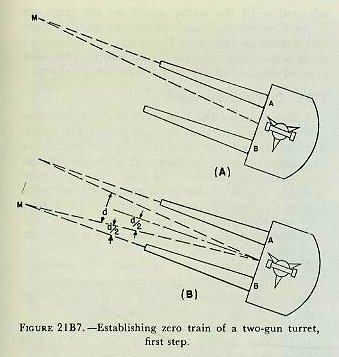 |
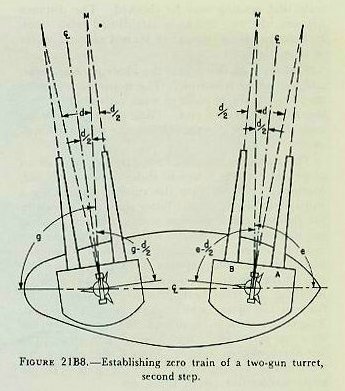 |